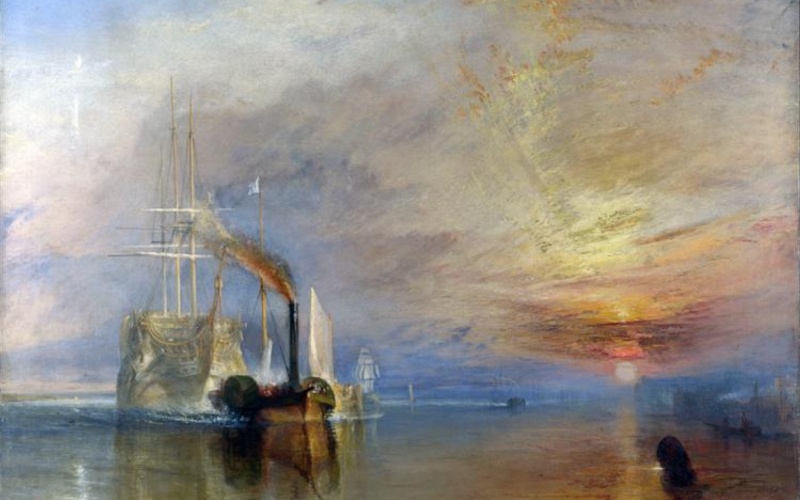An oil painting created in 1839 by the English artist Joseph Mallord William Turner depicts the Fighting Temeraire tugged to her last berth to be broken up.
The 98-gun ship HMS Temeraire, one of the last inferior ships of the line that distinguished itself in the Battle of Trafalgar in 1805, is shown being pulled by a paddle-wheel steam tug into its final berth in Rotherhithe, south-east London, in 1838, when it would be dismantled for scrap.
The artist left the picture to the country in 1851, and it now hangs in the National Gallery in London. In a survey conducted by BBC Radio 4’s Today programme in 2005, it was chosen as the country’s favorite artwork.
Sir Henry Newbolt wrote a ballad titled The Fighting Temeraire, referencing the scenario depicted: “And she’s fading down the river, But in England’s song for ever, She’s the Fighting Téméraire.”
Turner himself presented the painting for display in 1839 accompanied by an altered excerpt from Thomas Campbell’s poem Ye Mariners of England, reading: “The flag which braved the battle and the breeze,/No longer owns her.”
Turner was at the pinnacle of his career and had been exhibiting at the Royal Academy in London for 40 years when he decided to paint this picture in 1839.
He was recognized for his intensely atmospheric works in which he examined the influences of light, weather, and the sea. He spent a large portion of his life close to the River Thames estuary and produced numerous oil and watercolour paintings of ships and waterfront settings.
Turner often created quick sketches before developing them into finished paintings in his studio. He produced some sketches of the ship while watching it be towed.
In the finished painting, though, he does seem to have exercised some artistic license; it now has symbolic significance.
A ship is depicted in the painting being towed away for scrap. The ship has done enormous service for its nation and is now being withdrawn from society, therefore it is very metaphorical.
The antique warship, which is the most important element in the composition, is placed well to the left of the painting, rising in stately splendour and nearly ghostly hues against a triangle of blue sky and rising mist that brings it into sharp relief.
The tugboat, which scurries across the motionless surface of the river “like a water beetle” and is filthy, blackened, and has a tall smokestack, stands in stark contrast to the grandeur of the antique ship.
Turner has framed a second triangle of masted ships, which get smaller as they get farther away, within the triangle of blue. A small river boat with a gaff-rigged sail that is barely catching a breeze has been passed by the tugboat and the Temeraire.
A square-rigger drifts beyond this with all of its sails extended. Further down the river, another little ship is visible as a patch of white. A three-masted ship is anchored in the distance, beyond the second tugboat that is travelling in their direction. The becalmed sailing vessels show the obsolescence of sail.
The sun sets over the estuary, its rays reaching into the clouds above it and across the water’s surface, on the opposite side of the painting from Temeraire and exactly the same distance from the frame as the ship’s main mast.
The river reflects the burning crimson of the skies. It precisely duplicates the colour of the smoke that comes out of the tugboat’s funnel.
The sun setting represents the conclusion of a period in the British Royal Navy’s history. The painting’s theme is the decline of heroism, and it has been speculated that the ship represents the artist, who has had a distinguished and illustrious career but is now reflecting on his mortality.
Turner called the work his “darling”, which may have been due to its beauty, or his identification with the subject.


